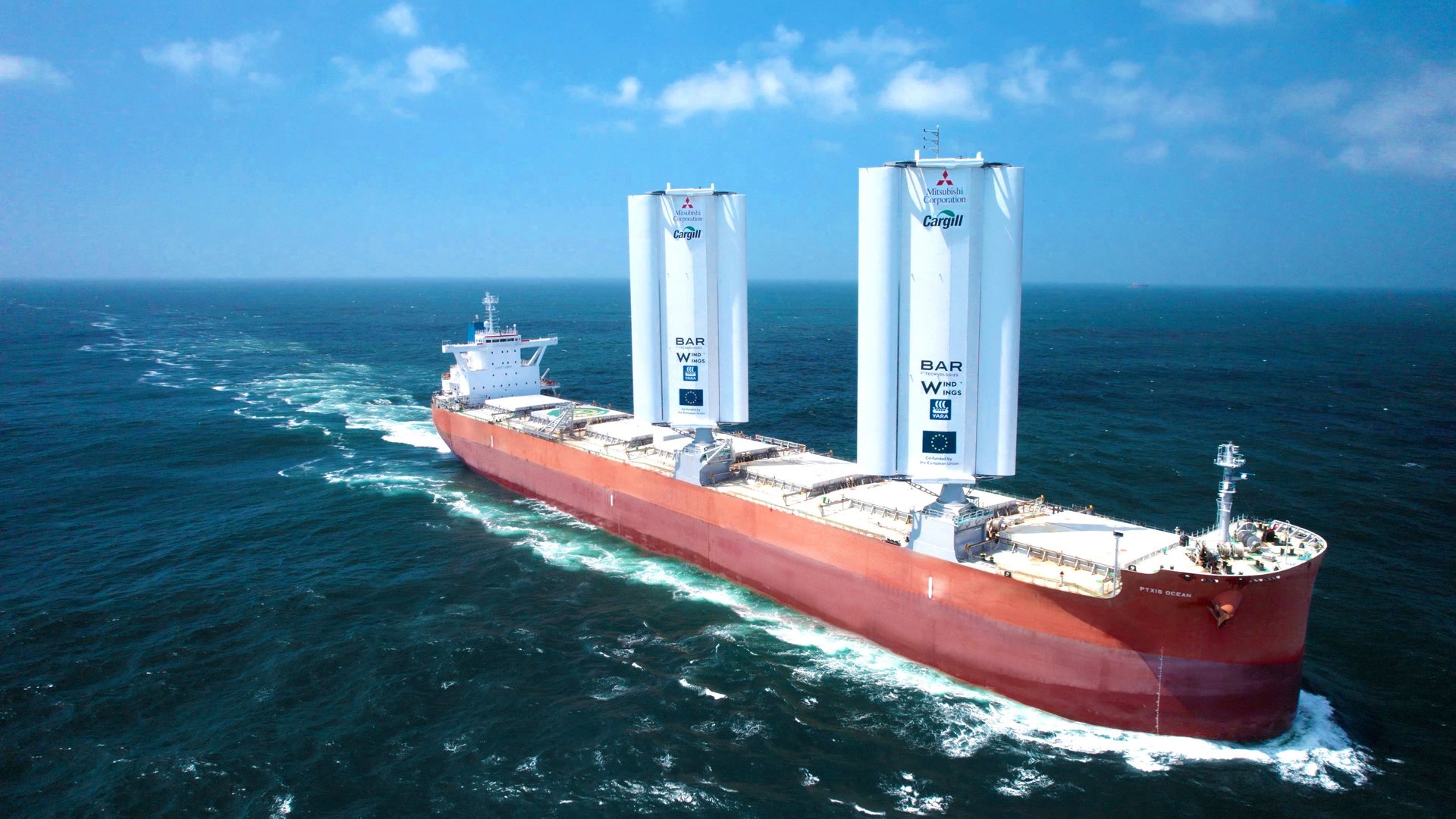A cargo ship that harnesses wind power has set sail on its maiden journey
The WindWings technology deployed on the Pyxis Ocean could cut fuel consumption by 30%

A cargo ship, typically a dirty oil guzzler, has taken to the open seas with a new green, clean technology onboard. The first vessel of its kind to be retrofitted with the technology called WindWings, the Pyxis Ocean has set sail from China with a lofty goals of helping the maritime industry decarbonize.
Suggested Reading
Agribusiness giant Cargill chartered the Mitsubishi Corporation vessel. The WindWings, described as “an advanced wind-assisted propulsion and route optimization system” in today’s (Aug. 21) press release, have been developed by UK-based design and engineering firm BAR Technologies and manufactured by Yara Marine Technologies.
Related Content
Harnessing wind power along the journey could lead to a 30% reduction in fuel consumption, cutting shipping’s carbon emissions. If the ship can stay the course, it could open doors to a greener future for the polluting industry, retrofitting a solution to decarbonize existing vessels, while offering new ones a sustainable design edge.
“A technology like WindWings doesn’t come without risk, and as an industry leader—in partnership with visionary shipowner Mitsubishi Corporation—we are not afraid to invest, take those risks and be transparent with our learnings to help our partners in maritime transition to a more sustainable future,” said Jan Dieleman, president of Cargill’s Ocean Transportation business. Speaking to Reuters, Dieleman said the Pyxis Ocean is expected to sail from Singapore to Brazil and is likely to deliver a cargo of grain to Denmark.
Cargill and its partners will evaluate the performance of the WindWings over the coming months to tweak the design and function fro scalability across not only Cargill’s fleet but the entire industry.
Company of interest: BAR Technologies
UK firm BAR Technologies was spun out of British competitive sailor Sir Ben Ainslie’s 2017 America’s Cup team—a competition that’s often referred to as the “Formula One of the seas.” The company’s process follows the Formula One racing playbook, with high-end simulation tools and AI design optimization, by tweaking latest hydrodynamics and foil assist technologies to boost efficiency.
It also features key Formula One racing personalities on its C-suite roster. CEO John Cooper, who spent 14 years working for Formula One team McLaren, swapped automotive technology for marine technology when he joined BAR Technologies in 2019. The team also includes former McLaren Formula One team principal Martin Whitmarsh as chairman and former America’s Cup designer and engineer Simon Schofield as chief technology officer.
Quotable: Wind beneath the shipping industry’s zero-emission wings
“Wind is a near-marginal cost-free fuel and the opportunity for reducing emissions, alongside significant efficiency gains in vessel operating costs, is substantial. Today is the culmination of years of pioneering research, where we’ve invested in our unique wind sail technology and sought out a skilled industrialization partner in Yara Marine Technologies, in order to provide.”
—BAR Technologies CEO John Cooper in a press statement on Aug. 20
Sailing with wind, by the digits
30%: Reduction in fuel consumption and CO2 emissions that Windwings can achieve on average trading patterns, according to simulations. “This could be even higher if used in combination with alternative fuels,” Cargill and BAR Technologies said in their press release
37 meters: Size of the solid wing sails—made from the same material as wind turbines—featured in the system, which are fitted to the deck of bulk cargo ships
751 meters: Length of the ship Cargill has chartered, equivalent to two American football fields
3 tonnes: Fuel the system will enable the ship to save per day, as per BAT Technologies
6 weeks: Length of Pyxis Ocean’s journey from China to Brazil
55%: Percentage of the world’s bulker fleets that are up to nine years in age
Hundreds: Wings developer BAR Technologies and manufacturer Yara Marine Technologies plan to build over the next four years
Half: Share of new-build ships “that will be ordered with wind propulsion,” according to BAR Technologies’ Cooper
2.2%: Share of global carbon dioxide (CO2) emissions from international shipping is responsible, according to the UN
23: Large ships equipped with some form of “wind assist” technology over the past 12 years, Gavin Allwright, secretary of the International Windship Association, in a statement in July. The figure is expected to double over the next 12 months
12: Wind propulsion systems on the market, with as many as seven more coming online in 2023, according to Allwright. These include Helsinki-based Norsepower Oy’s rotor sails, tire company Michelin’s inflatable and retractable automated wing sail, Netherlands-based Econowind BV’s Ventifoil wing-shaped suction-based device, and more.
A non-exhaustive list of other ways shipping is going green
Other green fuel options that the maritime industry is exploring to cut its carbon emissions include green hydrogen, ammonia, and methanol. However, none of these alternate fuels will be available before at least 2030 because they’re plagued by myriad challenges including:
🔬 A lack of significant infrastructure for production and distribution and a more expensive manufacturing process for green hydrogen compared to fossil fuels and fossil fuels-derived hydrogen;
☣️ Toxicity challenges, especially for flammable and corrosive ammonia;
⚡ Low energy density in the case of methanol;
📄 Limited research into efficiency and scalability, both from a science and regulatory perspective, in all three cases.
Learn more about car shipping and the factors that affect costs:
Quartz is not involved in creating these articles but may receive a commission from purchases through its content:
Related stories
⛵ In the future, huge ships will be wind-powered like sailboats